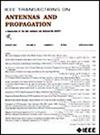Parity-Time Symmetry and Leaky Wave Antennas: A Generalized Dispersion Equation
IF 4.6
1区 计算机科学
Q1 ENGINEERING, ELECTRICAL & ELECTRONIC
引用次数: 0
Abstract
A generalized dispersion equation is derived featuring coupled mode theory, parity-time (PT) symmetry, and leaky wave antennas of arbitrary periodic modulation. It can be specialized to each of these cases individually or can describe a structure containing all three electromagnetic phenomena simultaneously in a single antenna. This very general dispersion equation (GDE) is derived using both mode matching and the transverse resonance method, the latter lacking the ability to provide the field descriptions and wave impedances with the advantage of computational simplicity. The dispersion equation is first used to design a parity-time symmetric waveguide consisting of conjugate impedance sheets coupled in close proximity. The example shows both the eigenvalues (wavenumbers) and eigenvectors (modes) coalescing at a single point in the parameter space known as the exceptional point. In another example, the same dispersion equation is again used to model a sinusoidally modulated reactive sheet (SMRS) supported by an active impedance sheet-backed dielectric spacer. The active impedance sheet is designed to compensate for the SMRS radiative leakage loss when coupled in close proximity. Hence, each spatial harmonic is described by a purely real wavenumber despite the radiative losses to the open far-field channel. Plots of the spatial harmonics show a constant amplitude envelope and hence leaky wave radiation is generated from spatial harmonics which do not decay as they leak. Full-wave simulations corroborate our results.奇偶时间对称性和漏波天线:一个广义色散方程
推导了具有耦合模理论、奇偶时间对称性和任意周期调制漏波天线的广义色散方程。它可以专门用于这些情况中的每一种,也可以描述在单个天线中同时包含所有三种电磁现象的结构。这种非常一般的色散方程(GDE)是用模式匹配法和横向共振法推导出来的,后者缺乏提供场描述和波阻抗的能力,但计算简单。首先利用色散方程设计了由共轭阻抗片紧密耦合组成的奇偶时对称波导。该示例显示了特征值(波数)和特征向量(模式)在参数空间中称为异常点的单个点上合并。在另一个例子中,同样的色散方程再次用于模拟由有源阻抗片支撑的正弦调制无功片(SMRS)。有源阻抗片的设计是为了补偿SMRS在近距离耦合时的辐射泄漏损失。因此,尽管对开放远场信道有辐射损失,但每个空间谐波都用纯实波数来描述。空间谐波的图显示出一个恒定的振幅包络,因此泄漏波辐射是由空间谐波产生的,这些空间谐波在泄漏时不会衰减。全波模拟证实了我们的结果。
本文章由计算机程序翻译,如有差异,请以英文原文为准。
求助全文
约1分钟内获得全文
求助全文
来源期刊
CiteScore
10.40
自引率
28.10%
发文量
968
审稿时长
4.7 months
期刊介绍:
IEEE Transactions on Antennas and Propagation includes theoretical and experimental advances in antennas, including design and development, and in the propagation of electromagnetic waves, including scattering, diffraction, and interaction with continuous media; and applications pertaining to antennas and propagation, such as remote sensing, applied optics, and millimeter and submillimeter wave techniques

 求助内容:
求助内容: 应助结果提醒方式:
应助结果提醒方式:


